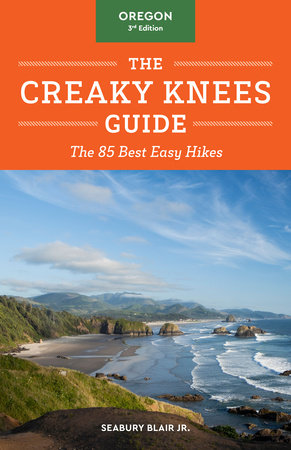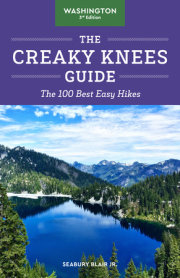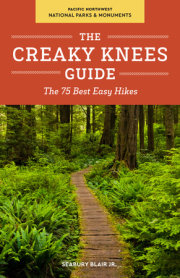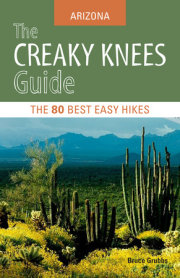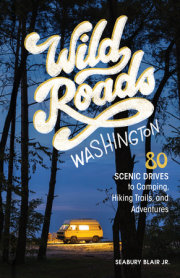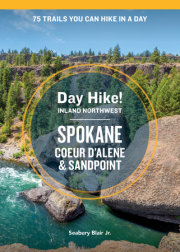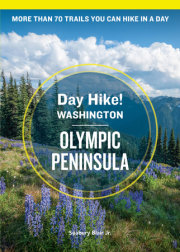IntroductionAs you read these lines, I’ll be celebrating my eighth decade on this planet by taking many of the hikes outlined in this book. I’ve been incredibly lucky to have avoided most of the maladies and ailments that cause those of us who love nature to curse our joints and bones for keep-ing us from the wild places, the places our hearts yearn to see once more. Yet I’m not immune to the greatest handicap of all—advancing age—and it has altered my approach to wilderness pathways, both mentally and physically.It has also changed the way I reviewed the hikes in this, the third edition of The Creaky Knees Guide: Oregon. With few exceptions, the hikes and trails have not changed, but I’ve tried to look at them from the standpoint of a wilderness pedestrian who can no longer hike 3 miles an hour for 17 hours straight across the Olympic Mountains, which I did three decades ago; or climb 8 miles and 3,700 vertical feet up Scotchman Peak, which I did four years ago. Both are but minor accomplishments compared to the many folks, older than me, who gallop from one side of the Grand Canyon to the other in a single day, or zip up Denali with minimal support. Still, we all tend to accept the reality that we can’t enjoy our wild world the way we used to, while clinging to the wish that we could.So that was my focus in revising this guide. Wherever I thought it necessary, I mentioned the fact that you needn’t walk the trail as far as I suggest. In most cases, it’s an arbitrary destination and has little to do with the scenery, flora, or fauna you’ll see along the way. Far more important, it seems to me, is getting on the trail, no matter the distance you travel. The forest you enter at the trailhead is the same as that five miles away; the river you walk beside is no wilder a half-mile from the parking area as it is three miles up- or downstream. All of our wild places are just as beautiful, just as magnificent, just as wild a few hun-dred steps up the trail as they are a few miles along.It doesn’t matter how far you walk or how fast you walk, or even if you walk—I’ve paid special attention to pointing out accessible trails— I think what really matters is that you walk. Or hobble, limp, wheel, or—my favorite mode of trail travel these days—waddle.Since I started hiking Oregon’s wilderness pathways, shortly after the last ice age, I’ve been both encouraged and saddened by the fact that more people are using the trails these days. In 1974, it was a surprise on a summer weekend to find more than two dozen people hiking to Mirror Lake. Today, you are fortunate to find a parking space in the huge lot along Highway 26. Some trailheads are so crowded that hikers are forced to park parallel along the approach road, forcing forest managers to enforce limits or require permits.What good can come of overcrowding? Every person experiencing a wilderness outing for the first time could become an advocate for trails in the future. I hope they will join a growing constituency of users, folks dedicated to improving trails and managing our wild pathways in a manner that alleviates the impact of increased use. Such organizations as Trailkeepers of Oregon, Mazamas, Friends of the Columbia Gorge, and Sierra Club chapters all join with national and state wilderness managers to improve and protect our trails.Oregon trails provide rare diversity in the places we can hobble, limp, wheel, or waddle. As diverse as they are, they all share at least one ele-ment: exceptional beauty. The mossy, fern-festooned rain forests of Fort Stevens. The receding glaciers of Mount Hood. The alpine meadows of Crater Lake. The sage and sand of the Crooked River. All of these places look about the same from mile marker one to mile three and perhaps beyond.All the people I met who hike the wild pathways of Oregon will tell you the same thing: walking is the best thing you can do for your soul and your body—especially if you are surrounded by the beauty you can find around this neck of the woods. Age and physical condition are simply not as important to them as getting outside to see what surprises Mother Nature has for them. It is in that spirit that I offer this guide to all of you.
Copyright © 2022 by Seabury Blair Jr.. All rights reserved. No part of this excerpt may be reproduced or reprinted without permission in writing from the publisher.





